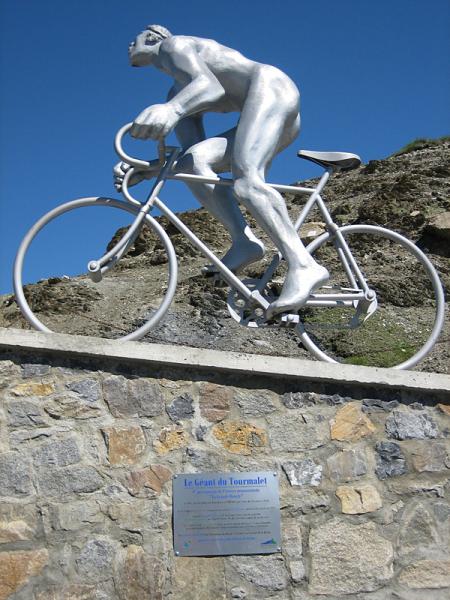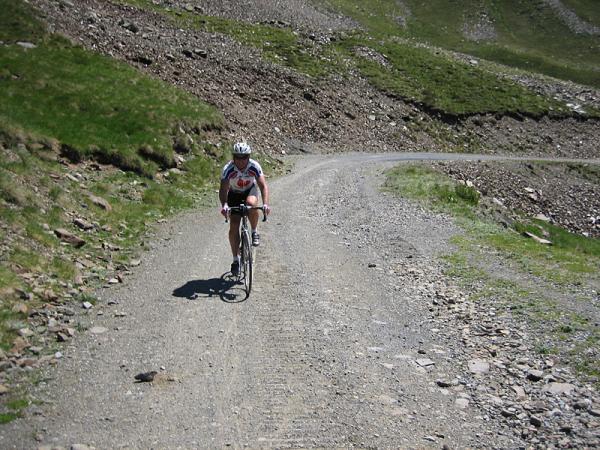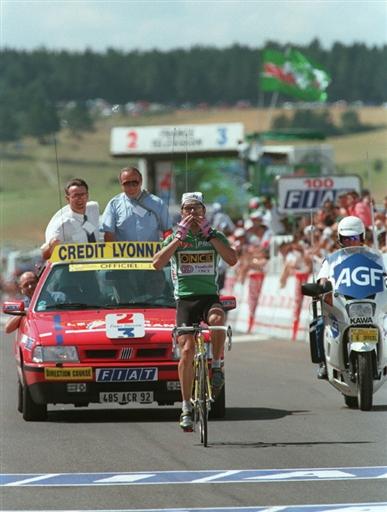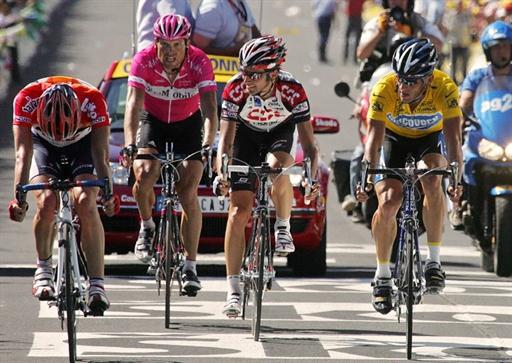2010 Tour de France route historic, but pulls punches
Passing over historic climbs, the route has a surprisingly small number of mountain top finishes.




The Tour de France organisers rolled out a 'classic' route for the 2010 race, taking in many of the big mountains of the Alps and Pyrenees. Yet the race will only have three summit finishes. Have the organisers scrapped drama for paying homage to the race's history?
Tour organisers ASO have included many of the climbs which made the Tour de France what it is today for the 97th edition, but have chosen to place the finish lines of several key stages far beyond the summits of even the Col d'Aubisque, the site of many epic battles in Tour history.
The first summit finish comes at Morzine-Avoriaz on stage 8, but after the first rest day, the race passes over the Col de la Madeleine before finishing in Saint-Jean-de-Maurienne more than 30km away. The scenario is repeated on stage 15 when the Port de Bales is crested over 20km from the finish in Luchon, and again on stage 16 when the race peaks at the Col d'Aubisque before heading a massive 58km to Pau. What follows the second rest day, however, is the most epic of summit finishes, the Col du Tourmalet.
Having a finish in Luchon is understandable, as this was the finish town of the Tour's first ever mountain stage and the town is steeped in Tour history, but the race organizers could have added some more excitement to the event by adding at least one, if not two, more mountain-top finishes to the program.
The origin of the mountain stage
The mountain stages have been critical to making the Tour de France the spectacle that it is, but the race didn't always include high mountains in its program. The first notable climbs in the Tour de France came in 1905, the third year of the race. However, it wasn't until 1910 that high mountain stages appeared in the race.
Back in 1910, when Tour director Henri Desgranges sent his assistant, Alphonse Stienes, to check out the climbs in the Pyrenees, it was mid-winter and the roads were choked with snow. Stienes crossed the Tourmalet, but on foot, late at night and when the search party found him the next morning and brought him to safety, he reported back to Desgranges that the climb was perfectly passable.
The latest race content, interviews, features, reviews and expert buying guides, direct to your inbox!
The first ever mountain stage was a 289km romp from Perpignan on the Mediterranean Sea to Luchon, including the Col du Port, Col du Portet d'Aspet and Col des Ares. After a rest day, that was followed by the 326km stage from Luchon to Bayonne on the Atlantic Ocean crossing the Col de Peyresourde, Col d'Aspin, Col du Tourmalet and the Col d'Aubisque. These four passes were nicknamed the "Circle of Death". Given the conditions of the roads and bicycles at the time, the named seemed completely appropriate.
Race organizers were interested in to see if any racer could ride over all four passes. Their question was answered when 1910 winner Octavio Lapize appeared near the top of the final climb, the Aubisque, pushing his bike. He shouted 'assassins' at the race organizers witnessing his plight.
The Pyrenees and the 'Circle of Death'
To pay homage to those first two mountain stages, the race organizers have included all the critical elements of those historic routes. For 2010, stage 15 includes the Portet d'Aspet and the Col des Ares, but also adds the difficult Port de Bales before the fast, downhill run into Luchon after 187km of racing.
Stage 16 crosses the "Circle of Death" and finishes its 196km course in Pau. This is a supremely difficult stage, but it is 58km from the top of the Aubisque to Pau. Unless this stage is ridden at a moderate tempo, it is not likely that the overall contenders will have many teammates to neutralize any breakaways. Cooperation among competitors will most likely be required if anybody dangerous does get up the road.
These two stages highlight four tough days in the Pyrenees during the last week that will most undoubtedly shape the 2010 Tour much like the final week in the Alps in 2009. The upside is that those alpine stages last year provided almost endless drama and were in stark contrast to the first two weeks which could best be described as 'tactical.'
To be sure, if you were a sprinter or a stage hunter, the first couple of weeks were not a snooze, but from the perspective of the race for the yellow jersey, things were a bit boring.
A variety of challenges in Tour's first half
While there may be a repeat of the tactical nature in the first two weeks of the 2010 Tour, there are plenty of opportunities to both win or lose the race before the Pyrenees are reached. The overall contenders will need to be up front and out of trouble when stage 3 from Wanze to Arenberg Porte du Hainault tackles seven cobbled sections totally 13km with the final section occurring only 10km from the finish. In 2004, Iban Mayo put paid to his overall chances with an untimely fall on the pave.
The Alps offer up several opportunities to thin out the contenders. The final climb to the Station des Rousses on Stage 7 is 7km at 5% which could open some minor time gaps.
The next day, the 189km stage 8 from Station des Rousses to Avoriaz includes the Col de la Ramaz only 40km from the finish. This could be one of the sleeper climbs of the Tour. While it averages a moderate 7% over its 14km length, there is a 4km section mid-climb at 9% which could see an attack by riders like the Brothers Schleck, much in the same way they animated the 2009 race.
Stage 8 finishes at Avoriaz the scene of some epic battles in the mid-80's between Bernard Hinault and Colombian Lucho Herrera. Avoriaz is very similar in length and difficulty to the Verbier climb from the 2009 Tour.
On paper, the most difficult day in the Alps is stage 9 with four major climbs, Col de la Colombiere, Col de Aravis, Col des Saises and Col de la Madeleine, between Morzine and the Saint Jean-de-Maurienne. All these climbs have major alpine pedigrees, but the top of the Madeliene is 32km from the finish. Most of those miles are more than a 5000-foot technical descent, but the final 13km are a slightly uphill to the line which means that a motivated group could bring back a small breakaway if necessary.
Watch out for the "medium" mountain stages
One of the more interesting stages could be stage 12 from Bourg-de-Peage to Mende which clocks in at 210km. The final climb is the Cote de la Croix Neuve renamed Montee Laurent Jalabert because he won here in 1995 on Bastille Day. This is a 3km, 10+% ascent which, in 2005, saw Lance Armstrong, Jan Ullrich, Ivan Basso and Cadel Evans drop all their competitors in an all-out slugfest.
This elite group was climbing at a spectacular Vertical Ascent in Meters (VAM) of 1800+ with Lance averaging over 450 watts. The climb isn't long enough to open any really significant time gaps, but it will clearly tell who has the form as the race reaches the Pyrenees the very next day.
One thing I would liked to have seen the race organizers of the Tour do was to follow the lead of the Giro and include some dirt roads. Those first mountain stages in the Pyrenees were run on some very sketchy terrain, pavement was way off in the future for climbs like the Tourmalet.
There are several good candidates for including dirt, most notably the 6km road that heads from the top of the Col du Tourmalet to the Col de Sencours. At 2378m it would be the second highest mountain top finish in Tour history. The road is in very good shape, much better than the Plan de Corones used in the Giro. Adding the Sencours would definitely pay homage to those first riders who struggled into the unknown on fixed gear bicycles and no mechanical support.
With Astana weakened by the departure of both Lance Armstrong and Andreas Kloden and the uncertainty of where Alberto Contador will ultimately land, it is likely that there will not be one very strong team in the 2010 Tour. This may, unlike 2009, open up the first two weeks of racing and add some significance to the alpine stages. If not then then one can only hope that the four stages in the Pyrenees provide the multitude of fireworks we saw in the Alps in 2009.
